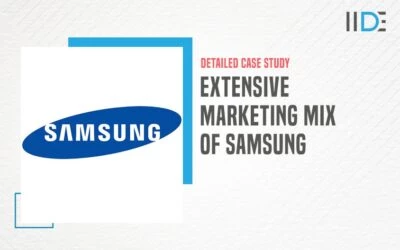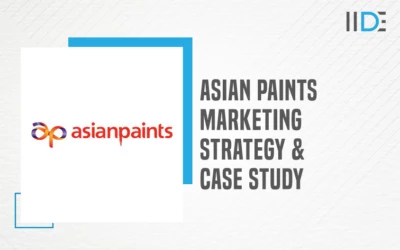India has various renowned banks currently operating in the country, both public as well as private sector banks. But the bank we shall be talking about in this case study has managed to stay relevant and capture 1/4th market share in the banking sector since its inception. It is the State Bank of India. The State Bank of India, also commonly known as SBI, is a Fortune 500 corporation. It is an Indian multinational banking and financial services statutory body.
In the SBI case study, we shall cover its marketing strategy, marketing mix, competitors’ analysis, digital marketing presence, and SWOT analysis.
But before we start delving into its marketing strategy, let us learn more about the company.
About State Bank of India

SBI is headquartered in Mumbai. It was founded on 1st July 1955, after the Government of India took control over the Imperial Bank of India and renamed it as State Bank of India. SBI has a rich history and legacy dating back over 200 years, making it one of the most trusted banks among Indians.
With a relentless emphasis on creativity and customer-centricity, it serves over 44 crore customers across a vast network of over 22,000 branches, 58,500 ATMs, and 66,000 BC outlets. The bank has 11 subsidiaries i.e. SBI General Insurance, SBI Life Insurance, SBI Mutual Fund, SBI Card, etc. It has a global presence, with 233 offices in 32 different countries operating across time zones. SBI is also the 43rd largest bank in the world and was the only Indian bank to be included in the Fortune Global 500 list, ranking in at the 221st position.
Now that we have an overview of the company’s background, let us proceed further with the marketing mix.
Marketing Mix of SBI
The marketing mix of any company includes four major components- Product, Price, Place, and Promotion. The mix refers to a company’s range of activities or strategies, set up for promoting its service or product in the marketplace. Following is the marketing mix of SBI:
Product

State Bank of India provides a variety of products to its retail and corporate customers through a network of branches across the globe. Some of its products include cards (debit and credit cards), savings accounts, fixed deposit accounts, recurring deposit accounts, foreign exchange services, tax saving bonds, loans such as medical loans, mortgage loans, personal loans, and loans against securities.
It also provides services of general insurance, wealth management, asset management, private equity, and savings security, etc. The bank also has its own app now, called YONO, that facilitates digital banking right through customer’s fingertips.
Price
Since SBI has to work in a competitive marketplace, it has a clear-cut pricing policy. Hence, the bank uses competitive pricing. The government policies and decisions influence the pricing policies of the State Bank of India since banks have to strictly follow the regulations and guidelines set up by law. The Reserve Bank of India regulates the rate of interest according to which the pricing policies of the bank have to be determined.
The pricing strategies implemented by the bank are developed keeping in mind and examining the customer’s mindset and economic capability. For instance, the bank has a flexible policy for operating the home loan account- either in the current account mode or savings account mode.
Place

In the domestic market, the State Bank of India has over 22,000 branches and 66,000 BC outlets in various zones across the country. It’s worth mentioning that 66% of its branches are located in rural areas whereas only 34% of its branches are located in urban areas.
On the international front, the bank has more than 190 overseas offices spread across 36 countries in various cities like Moscow, London, Maldives, Dubai, New York, Dhaka to name a few. SBI has over 58,500 ATMs currently operating in India. These distribution channels are equipped with the latest technology, modern facilities, and advanced infrastructure.
Promotion
Proper strategies have been implemented by the bank in order to promote its services and facilities. Various promotional campaigns have been carried out through print and visual media via means such as hoardings, radio, TV, advertisements, and newspapers. Given its presence across India, its tagline, “The Banker to Every Indian,” proves to be perfectly fitting. SBI uses ads to effectively communicate its policies.
It has recently begun to adapt to the modern approach and create advertisements that reflect this change. As a result, it has used well-known personalities to reinforce the concepts of confidence in the minds of consumers. Because of the bank’s presence in almost every town, village, and area, it has been promoted indirectly by being present in the eyes of the customers constantly and regularly.
The marketing mix sums up the bank’s strategies in all four areas. All of the strategies are developed while keeping in mind the market standards and competitors’ strategies. Let us now understand how SBI ranks in comparison with other banks.
SBI’s Competitor Analysis
The major competitors of SBI are ICICI Bank, HDFC Bank, and Bank of India, among many others such as Axis Bank and the Indian Overseas Bank. Let’s quickly take a deeper look.
- SBI’s main competitor is ICICI Bank. ICICI Bank is a public company that was founded in 1955 in Mumbai, Maharashtra. ICICI Bank is a bank that operates in the same sector as SBI. In comparison to SBI, ICICI has 118,216 fewer workers. SBI is the largest amongst its competitors in terms of the number of employees.

- BOI (Bank of India) is also considered one of SBI’s major competitors. BOI was established in 1906 in Mumbai, Maharashtra. BOI generates $37.7 billion lesser in revenue than SBI. SBI ranks highest in revenue amongst its competitors with $44.5 B.

- Another competitor, HDFC is based in Mumbai, Maharashtra, and was established in 1994. In comparison to SBI, HDFC produces $33.1 billion fewer sales

All data points in one direction, and that is SBI’s superior ranking as compared to these competitors. Now that we thoroughly understand the bank’s market position and business, let’s finally take a look at its marketing strategy.
Marketing Strategy of SBI
In this section of the blog, we shall talk about the marketing strategy of SBI with the help of its STP i.e. SBI’s segmentation, targeting, and positioning strategies. Let’s get right into it.
SBI has been known to segment its market on the basis of the following variables:
- Geographic
- Demographic
- Behavioral
- Psychological
It accounts for people belonging to rural, urban, and metropolitan areas who are either self-employed, corporate, or government employees and targets them accordingly. It also targets students, people from poor households or lower class who are deprived of financial and banking facilities, and finally the tech-savvy business class for whom time is extremely important.
SBI has positioned itself as a trusted and reliable bank over the years. One that the citizens can always rely on, and that stands for the common man. It now also targets customers seeking value-additions with telebanking, net banking, digital banking, etc. This is how SBI accurately segments and targets its audience and positions itself accordingly.
In today’s times, it is also important to have a digital marketing presence, along with using traditional channels and tools. Let’s analyze SBI’s digital marketing presence.
SBI’s Digital Marketing Presence
The digital presence of any company is very crucial in this fast-moving modern world. SBI was quick to adapt itself to the technological changes and presently has an impressive social media presence. Following are the main takeaways from studying SBI’s digital presence:
- SBI has a strong social media presence with 2 million followers on Instagram, 4.2 million followers on Twitter, 3.57 lakh subscribers on youtube with videos having 2 crore+ views, and approximately 1.9 million followers on LinkedIn with over 61000 employees.
- SBI posts regularly on its social media platforms while consistently churning out relevant content.
- They also engage with their followers by asking questions, polling them, organizing quizzes on Instagram, etc.

- The company uses hashtags, especially on Twitter, to expand its reach effectively

- Festive marketing is also successfully carried out by the bank by providing special festive offers to customers and posting about them on their pages. And also by wishing their customers on all festivals.


- SBI has also introduced efficient digital banking methods. YONO (You Only Need One), as mentioned previously in the blog, is an SBI integrated digital banking platform that allows users to access a variety of financial and non-financial services such as flight, train, bus, and taxi bookings, online shopping, and medical bill payments. Customers can also access their SBI accounts directly through the YONO app for ease of access.
- The bank’s website is also very user-friendly and contains all the required information. It was revamped from its older versions to cater to the new generation of customers.
Lastly, let’s take a look at SBI’s SWOT analysis conducted from all the research carried out and information compiled in this blog.
SBI’s SWOT Analysis
A SWOT Analysis is one of the most widely used methods for evaluating a company’s internal and external environments and is part of the strategic planning process. A SWOT review aids decision-making by introducing opportunities to the enterprise and serving as a futuristic bridge for improvement. Following is SBI’s SWOT analysis:
Strengths of SBI
- SBI is the largest bank in India in terms of market share and branches
- It has more than 25000 outlets in the country. It also had a first-mover advantage in the commercial banking service industry
- Backed by the Government of India
- Commendable geographical reach
Weaknesses of SBI
- The complacency of employees because of higher job security results in a lack of motivation to work efficiently
- Despite the era of modernization, SBI still carries a perception of a traditional bank in the eyes of the new-age customers
Opportunities for SBI
- Greater expansion into rural areas
- With its wide reach, the bank could dominate the market as India moves toward cashless transactions
- Increased technological advances in the industry
Threats to SBI
- There could also be a possibility of a reduction in market share for SBI to one of its close competitors, ICICI Bank.
- There is also a serious threat to SBI in terms of acquiring new customers as they tend to avail the services of private banks.
- Government intervention
- Foreign entrants
Conclusion
The State Bank of India has certainly come a long way through its extensive journey. Being the largest public sector bank in India, SBI has been able to capture and retain a large chunk of the market. It is definitely no small feat. The bank has had its fair share of ups and downs but was able to tackle them all and maintain its reputed position. There’s no denying the fact that the public has started shifting more towards private sector banks, but there’s always room for growth and development. If SBI continues to adapt itself to the changing times and technological advances, by managing to change the perception of young professionals especially, it will surely be able to make a permanent place in the Indian banking industry.
Liked our work? Interested in learning more? Do check our website for extensive case studies, blogs, and presentations. You can also check out our Free Digital Marketing Masterclass by Karan Shah.
If you liked this blog, make sure to share, comment, and let us know!







0 Comments